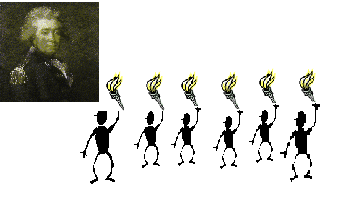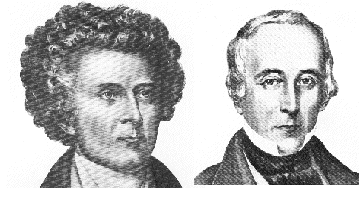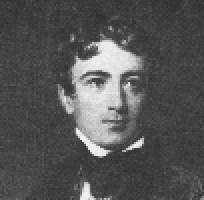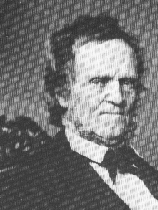
foreword | Historical Narratives | Resources | Links | Contact
ELIZABETH POSTHUMA SIMCOE, PART 3
History is a witness to the passing of time.
Goverrnor Simcoe requested permission to leave Upper Canada on sick leave. While Simcoe did suffer from various illnesses including neuralgia and gout, his request to leave was attributable as much to do mental anguish as to physical complaints. His torment was caused by the frequent frustrations he regularly experienced because of his inability to accomplish the objectives he had for the colony. Official approval finally came on the 14th of July. They were to sail from Quebec on the 4th of August on the armed frigate Pearl, Captain Sumuel Ballard in command. This left little time for goodbyes. The leave which was intended to be a temporary one actually became permanent. While Simcoe retained his title as lieutenant-governor of Upper Canadian until early in 1798, he never returned to his precious province.
 |
Leave-taking for Elizabeth was a wrenching experience. She "cried all day" and could eat nothing. It appears she made an exception, however, when Chief Wabakinine of the Mississauga and a number of his tribe at a gathering to compliment the governor on the eve of his departure presented the Simcoes with "the largest land tortoise I ever saw." The next evening the Simcoe entourage enjoyed a fine dish of "tortoise ready dressed."
The Simcoes boarded their ship at three in the afternoon on July 21st and after a salute from the vessels that bobbed about them "in the beautifully clear, transparent water" of little York's harbour, the Onondaga, the same schooner that had brought them to Newark almost exactly four years earlier, sailed away in a light wind "that raised the waves in a most sudden manner." They arrived at Kingston at 11:30 p.m. on July 25th.
For the journey down the St. Lawrence they transferred to bateaux. En route they slept in houses when clean ones could be found. If not they slept in tents or on the boats. Between Lake Ontario and Montreal the St. Lawrence was rough and broken dropping 68 metres in a series of boiling rapids spread over 192 kilometres. The Governor insisted on shooting the torrents which he found exhilarating, "the great width of the river adding terror to the scene of miles of foaming waves." Elizabeth preferred to travel overland.
Their departure from Quebec was delayed and they did not leave until September 10th when they finally boarded the ship, Pearl at Quebec City and cast off for home. The voyage was not without incident. Two French frigates hove into view and the pursuit was on. During the chase Elizabeth and the children hid below in the gun room. They eventually lost their pursuers and on October 12th anchored safely at Dover. As they travelled through the English countryside Elizabeth remarked how damp, raw and unpleasant the weather was. The fields looked cold and cheerless and
In Her Own Words"so uncomfortable for the want of our bright Canadian sun that the effect was striking and the contrast very unfavourable to the English climate."
 |
Ten days later the Simcoes drew up at the front door of Wolford Lodge, their home in Devon. Within two months of their arrival home Elizabeth was astonished to learn that the 'Governor' had accepted an appointment as commander-in-chief at San Domingo (Haiti). Both she and he knew the dangers to his health of service in such a fevered climate and Simcoe sought assurances that the government would provide for his family should he "perish in the mission upon which he was about to proceed." He was given this assurance by the prime minister himself before Simcoe sailed for the West Indies. Simcoe survived this assignment and on his return was given command for a time of the Western District prior to being appointed commander-in-chief of military forces in India. Before he could take up this challenge he died on October 26th, 1806.
The funeral plans which were prepared by Simcoe himself were worthy of a high-ranking officer. In the presence of many friends, Simcoe was "interred by torchlight" at Wolford Lodge in the cemetery outside the little he had built whose motto was "As for me and my house, we will serve the Lord."
 |
Devon county erected a monument to Simcoe at Exeter Cathedral. While it was under construction word was received that Simcoe's son, Francis, 21 had "fallen in the breach" at the siege of Badajoz in Spain on 6 April, 1812. An inscription commemorating the son was added to the bottom of the father's memorial.
Elizabeth had little time to lament her losses for she had the large estate to run and nine children to raise. She decided she could do this with less help and proceeded to reduce the number of servants she employed from fifty to seventeen. For the rest of her life Elizabeth continued to be interested in Upper Canada and closely followed reports that reached her regarding what she always referred to as "Simcoe's settlement." She was thrilled by its successful defence during the War of 1812 and declared that Brock had shown "the dash of a Simcoe."
When she learned of the rebellions of Upper and Lower Canada she was appalled and anxiously collected any news reports regarding them. This included copies of three Toronto newspapers which carried stories about an anticipated attack by Francis Bond Head on Navy Island. She doubted Head would ever approve such action and she was proven to be correct. She totally approved of Head's conduct as governor and thought his speeches to the Assembly "admirable," each containing "all one wanted to know in good language."
 |
She was alarmed to read in local newspapers about an international incident which might well have led to another war with the United States. Its cause was the Caroline, an American ship that ferried food, supplies and men to William Lyon Mackenzie's rag tag force on Navy Island. In order to put a stop to this traitorous traffic, the Caroline had been boarded and burned by Canadians in American waters. A London Fleet Street newspaper inaccuately featured a dramatic picture of the flaming vessel going over the cascading cataract. Americans were outraged by this brazen breech of the border and demanded revenge. Elizabeth feared the worse but was heartened to hear that it was Colonel Allan MacNab and not Bond Head who had been directly responsible.
Elizabeth kept abreast of news regarding the Canadian colony and when she heard Head would be returning home she rejoiced to learn that his replacement was Sir George Arthur another acquaintance. She believed a military man was needed in the Canadian colonies and was sure Arthur would do "just fine." When she recalled the 'Governor's' many disappointments, she commented that Arthur was welcome to the "thankless task."
 |
|
Sir Francis Bond Head & Sir George Arthur |
At the end of May 1839 the British government dispatched Lord Durham to Canada to investigate the causes of the conflict. Elizabeth disliked Durham and his liberal views and when she learned he had returned to England in a huff after serving only five months because he had failed to receive the support from the government he expected, she heaped scorn for the man and his mission. The 'Governor' had suffered the same fate but had remained at his post for four years. Elizabeth disagreed with Durham's recommendation of responsible government and firmly believed that Simcoe's constitution should not be altered. She also opposed the union of Upper and Lower Canada because she felt the French could never be assimilated for their language and religion were "too deeply ingrained." Elizabeth believed the solution to the situation in Canada would come only through "the church and the constitution." Otherwise Canadians might very well become "godless republicans" like their meddlesome neighbours to the south.
 |
|
John George Lambton, Lord Durham |
When the Bond Heads returned to England Elizabeth had them to dinner. She was eager to learn at first hand about events in Upper Canada. When he told her about his visit to Navy Island he remarked about
In His Own Words"that wretch Mackenzie who left a truly shocking mess with appallingly dirty, little huts and filthy clothes littered about." It was no more than he had expected of the rebels and their rioting leader.
 |
|
William Lyon Mackenzie |
As Elizabeth grew older she became domineering and dictatorial even denying her daughters the right to sit in her presence without permission. She never found any of their suitors worthy of the women and rejected all of them. Her word was law as far as the daughters were concerned consequently none of the daughters married during their mother's lifetime. They remained with their mother until her death on January 17th 1850 after forty-four years of widowhood. Only Anne, the youngest daughter, married at the age of forty-nine after her mother's death. He sisters felt she had married "beneath her station" and none of them attended the wedding. Anne was the last member of the original Simcoe family and she died in 1877.
The daughters maintained an ongoing interest in Upper Canada. When Bishop John Strachan wrote in 1859 about badly needed missions for the Aboriginals they responded by sending a hundred pounds. The eighty-two year old Strachan wrote and thanked them for their generous donation. He said the memory of their parents was cherished and their names were "household words" in Upper Canada. Elizabeth no less than the 'Governor' had given her name to the "letters and locations of this province."
Copyright © 2013 Website Administrator